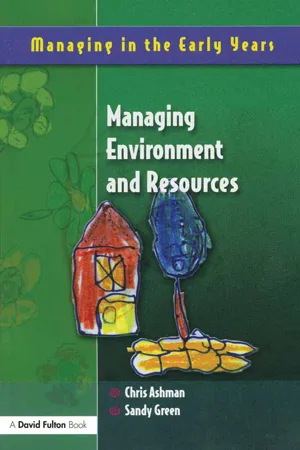
This is a test
- 78 pages
- English
- ePUB (mobile friendly)
- Available on iOS & Android
eBook - ePub
Managing Environment and Resources
Book details
Book preview
Table of contents
Citations
About This Book
Making management ideas easy to grasp and providing practical advice on management theory and practice, this book focuses on how to make policy work in practice:
- providing comprehensive advice on managing resources
- including advice on Health & Safety and promoting a healthy environment
- clear explanations of how to measure cost, incomes, ratios and effective efficiency
- Suggestions on how to bring about change and improvement.
Frequently asked questions
At the moment all of our mobile-responsive ePub books are available to download via the app. Most of our PDFs are also available to download and we're working on making the final remaining ones downloadable now. Learn more here.
Both plans give you full access to the library and all of Perlego’s features. The only differences are the price and subscription period: With the annual plan you’ll save around 30% compared to 12 months on the monthly plan.
We are an online textbook subscription service, where you can get access to an entire online library for less than the price of a single book per month. With over 1 million books across 1000+ topics, we’ve got you covered! Learn more here.
Look out for the read-aloud symbol on your next book to see if you can listen to it. The read-aloud tool reads text aloud for you, highlighting the text as it is being read. You can pause it, speed it up and slow it down. Learn more here.
Yes, you can access Managing Environment and Resources by Chris Ashman in PDF and/or ePUB format, as well as other popular books in Pedagogía & Educación general. We have over one million books available in our catalogue for you to explore.
Information
Chapter 1
MONEY MATTERS
This chapter covers:
● Useful methods to help you manage money
● How to set a budget and monitor spending
● Managing income and expenditure
Some people are spenders and others savers! Managers need to be good at both things: spending time, money and resources to get the job done as efficiently and effectively as possible; and saving energy, time and resources to reinvest in other activities.
Some people are very comfortable using numbers in their daily life and their working environment. Others may have an instant reaction of ‘I can't do the maths!’

Who is the role model?
As an Early Years manager you will already work with numbers and money. As with other things, the more you use and practise the skills the more comfortable you will feel about using them.
USEFUL METHODS TO HELP YOU MANAGE MONEY
Planning is a skill you already possess. Within your practitioner role you will have developed methods to create ideas, organise activities and identify ways of evaluating outcomes for a whole range of curriculum-related actions. Managing money will call on many of these skills. When planning finance or money, management budgets will be used to set out aims and then monitor progress.
Definition
Budgets are plans that relate to activities measured by numbers.
Do not be afraid of your budget! It is a very useful system to control resources.
Examples of budgets will include:
❑ Ratios – lists of the total number of children in an age range compared to the total of qualified and unqualified staff on duty
❑ Salary costs – of employing staff
❑ Estimates – of the bills expected for consumables or gas, electricity, water, etc.
In this chapter it will be the budgets that we focus on. Understanding and using such financial plans and monitoring processes are vital aspects of any manager's successful career. It may not seem exciting to be a good financial manager, but even if your curriculum activities or your support of parents is superb, you still need to be solvent to carry on next year.
Setting a budget
Often you will be asked to set a budget, to create a plan, alongside other managers. Depending upon the size of the organisation that you work for, the budgets may be set by financial experts, the senior manager or owner of the service.
Even if you are not directly involved in deciding what goes into a budget plan it is important for you to have an understanding of how budgets are set. Such an understanding helps you to manage it more efficiently and effectively.
There are two broad approaches to setting a budget that can be categorised as (a) annual update and (b) blank sheet.
Annual-update budgets
When planning personal spending many people will go through a process similar to this, perhaps on a monthly basis:
❑ I need to know how much money I will receive – e.g. monthly salary
❑ Allocate regular expenses that are fixed – e.g. rent or mortgage, insurance
❑ Allocate money for other regular expenses that may vary from month to month – e.g. food bills, entertainment, travel and transport, savings or paying off debts.
Some people do this as a conscious activity by getting bank statements, salary slips, utility bills, shopping receipts or other documents and working out the difference between income (salary) and expenditure (outgoings). Other people do something less consciously, but they have to do something to make sure that over time they have the money to spend on necessary things as well as desirable things.

Managers need to consciously plan and check the money. Taking the less conscious approach is inappropriate. Remember that as a manager the money you are dealing with, whether it ...
Table of contents
- Cover
- Half Title
- Also Available
- Title Page
- Copyright Page
- Table of Contents
- Acknowledgement
- Introduction
- Chapter 1: Money Matters
- Chapter 2: Managing To Be Healthy and Safe
- Chapter 3: Beyond Compliance
- Index